Ion Channel Solutions
High-Quality PrecisION® Cell Lines for Target Discovery, Hit Screening, Lead Optimization, and Safety Studies
Ion channels continue to be an important therapeutic target for a wide range of indications, including arrhythmia, hypertension, local anesthesia, pain, stroke, epilepsy, depression, bipolar disorder, cystic fibrosis, cardiac arrhythmias, COPD, autoimmune disorders, and diabetes. They are an appealing target to develop therapeutics against rare channelopathies, since many of these diseases are caused by the mutation of a single gene. Ion channels not only constitute a significant class of drug targets, they are also critical for evaluating drug safety, including being part of the U.S. FDA required safety testing for any drug targeted against human disease.
Eurofins DiscoverX®’s comprehensive portfolio of functionally validated ion channel products is comprised of optimized and PrecisION stable ion-channel cell lines for use in cell-based assays, PathHunter® pharmacotrafficking assays for pharmacochaperone discovery, and an hERG ion channel membrane preps for binding studies.
The vast ion channel product solutions include assessment of voltage-gated, ligand-gated, and several other targets for screening ion channel inhibitors for your drug discovery and safety applications. The ion channel cell lines are pharmacologically and functionally validated using in-house discovery and safety services laboratories. Their biophysical and pharmacological properties are characterized electrophysiologically using conventional manual patch-clamp and multiple automated patch-clamp platforms by experienced electrophysiologists in both Eurofins Discovery services and Eurofins DiscoverX products laboratories.
Product Highlights
- Validated – Functionally and pharmacologically validated ion channel cell lines used in Drug Discovery & Safety programs both in house and at customer sites, with many cell lines in use for over ten years
- Superior Performance - Proprietary cell line vector technologies for optimum stability, expression, and uniform current
- Versatile Use – PrecisION cell lines applicable for manual and automated patch-clamp studies, PathHunter pharmacotrafficking hERG & CFTR cell lines for pharmacochaperone discovery, and PrecisION hERG membrane prep for safety binding studies
Representative ion channel characterization data for ionic currents, channel biophysical properties, and pharmacology.
Current-Voltage (I/V) Relationship Data for Voltage-Gated Ion Channels

Raw Data Currents and the Current-Voltage (I/V) Relationship. The first step in characterizing a voltage-gated ion channel (VGIC) is to generate an I/V relationship. This relationship measures the amount of current that passes through the channel when a series of voltage-steps are applied to the interior of the cell. A. Resulting ionic currents for the family of voltage steps is shown in (B.). C. A plot of the peak current amplitudes versus voltage. In this example, the voltage steps are eliciting t-type calcium channel (CaV3.2) ionic currents. A similar process is followed for characterizing any voltage gated ion channel measured using patch clamp technologies. Vm = membrane voltage; Im = membrane current (Manual Patch Clamp Data)
Biophysics of Channel Activation and Inactivation
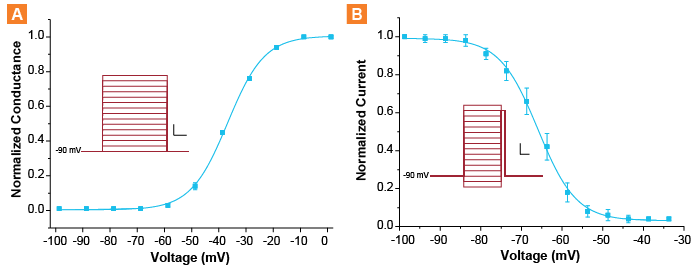
Voltage-Dependence of Activation and Inactivation. The next step in characterizing a VGIC is to measure the characteristics of voltage-activation and inactivation (when inactivation is present). In this case, the CaV3.2 calcium channel is used again as an example. A standard Hodgkin-Huxley type analysis is performed to measure voltage-activation and inactivation characteristics. Voltage-dependence of activation (A.) and inactivation (B.) are plotted and fit with a Boltzman equation to determine V1/2 values. The voltage protocols used are shown (insets) in each panel. (Manual Patch Clamp Data)
Pharmacological Profiling
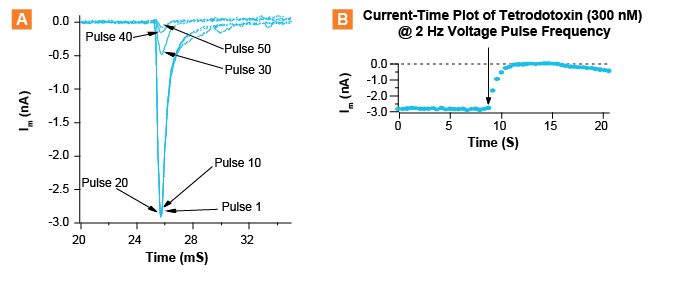
Measuring Ion Channel Pharmacology: The next step in characterizing a VGIC prior to any discovery or safety studies is to look at the pharmacology of known compounds that affect the ion channel. A. A voltage step to perform the assay is selected based on the ion channel’s voltage characteristics, where a robust signal can be measured. That voltage step is then delivered at regular intervals until a steady-state is reached prior to adding known or test compounds. In this example, a step to 0 mV is delivered at a 2 Hz fixed frequency. Individual peak current responses to delivered voltage steps are plotted prior to compound application (Pulses 1, 10, and 20), and after application of test compound (Pulses 30, 40, 50). B. Current-time (I-t) plot showing the steady-state control period, followed by addition of the compound, and its effect on the magnitude of the ionic currents. In this example, Tetrodotoxin (TTX) was tested for potency against the human sodium channel NaV1.2. (Manual Patch Clamp Data)
Rank Order Potency
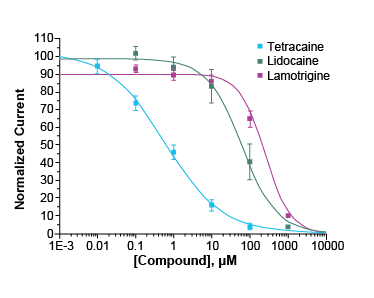
Dose Response Curves for Ion Channel Inhibitors Reveal Rank Order Potency. Human sodium channel NaV1.8/β1 pharmacological dose-response curves for 3 sodium ion [Na+] channel blocking compounds (Tetracaine, Lidocaine, and Lamotrigine) to determine rank-order potency. (Manual Patch Clamp Data)
Current Activation by Increasing Concentrations of Agonist

Raw Data Currents Elicited by Bath Application of Agonist. Cells are voltage-clamped at the desired voltage, in this case -60 mV. Ligand is then added by a 2 second perfusion pulse at 1 minute intervals in increasing concentrations to activate the currents. In this example, human acetylcholine receptor channel nAChR α1/β1/δ/ε was activated by acetylcholine. Increasing current activation is shown when increasing the concentrations of agonist are applied. (Manual Patch-Clamp Data)
Agonist Activation Profiles
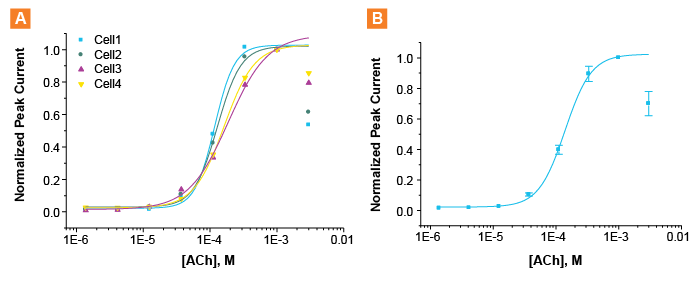
Agonist Activation of Acetylcholine Receptors. A. Agonist concentration-response curves for acetylcholine (Ach)-evoked currents. The x-axis shows the log concentration of ACh (M) and the y-axis the peak current amplitude normalized to the 1 mM evoked current amplitude value. Each point represents the single value from each tested cell (4 cells tested). B. Mean data. EC50 value = 140 ± 6.2 μM (mean ± SEM, n=4). In these examples, the human acetylcholine receptor channel nAChR α3/β4 was used. (Manual Patch-Clamp Data)
Agonist Activation Profiles Agonist and Antagonist Dose Responses (Fluorescent Assay Experiments)

Activation of Acetylcholine Receptors by Multiple Agonists and Inhibition by Multiple Antagonists. A. To assess agonist pharmacology, 3 compounds were tested. EC50 values are shown in the table below the figure. The values obtained are in close agreement with published data for calcium ion [Ca2+] flux experiments. B. To assess antagonist pharmacology, the ability of 3 compounds to inhibit the epibatidine response at its EC80 concentration on the day of assay (6-10 μM) was tested. IC50 values for the block of the epibatidine response are shown in the table below the figure. In these examples, the human acetylcholine receptor channel nAChR α3/β4 cell line was used. (FLIPR Data)
Agonist and Antagonist Dose Responses (Electrophysiology Assay Experiments)
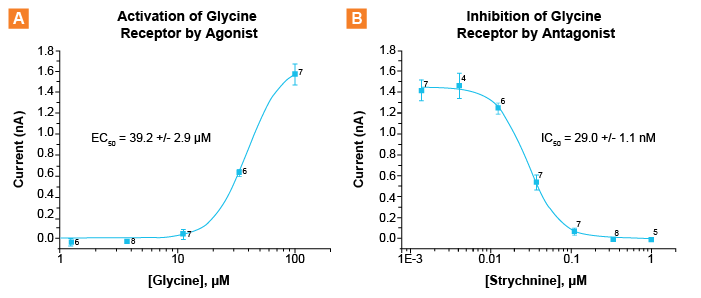
Activation of the Glycine Receptor by Agonist and Inhibition by Antagonist. A. Increasing concentrations of glycine were added to and the evoked outward current at 0 mV was measured. Glycine dose-dependently increased the outward current with an EC50 of 39 μM. B. Various concentrations of strychnine were incubated for 100 seconds and then 100 μM glycine was added. Strychnine dose-dependently inhibited glycine evoked outward currents with an IC50 of 29 nM. In these examples, the human glycine receptor hGlyRA1 cell line was used. (IonWorks Quattro Data)
Functionally validated ion channel products for drug discovery and safety pharmacology
Read MoreComprehensive Eurofins DiscoverX product list to enable your drug discovery and development programs focused on checkpoint receptors, cytokine receptors/interleukins, cytotoxicity,…
Read MoreLearn about PathHunter pharmacotrafficking assays to identify small molecule compounds that rescue disease relevant mutant membrane proteins like GPCRs, ion…
Watch NowLearn about Eurofins DiscoverX cell line engineering, assay development, and recombinant enzyme production custom capabilities. Find out more about cell…
Watch NowDrug Discovery for Ion Channels XXIII Satellite Meeting
Read MoreDiscoveRx® has pioneered a novel enzyme complementation system to monitor cellular events such as protein translocation, protein interactions, and degradation…
Read MoreDiscoveRx® has pioneered a novel enzyme complementation system to monitor cellular events such as protein translocation, protein interactions, and degradation…
Read MoreCystic fibrosis (CF) patients have mutations in the cystic fibrosis transmembrane conductance regulator (CFTR) chloride channel that result in reduced…
Read MoreTranslocation and Trafficking of Membrane Proteins
Read MoreRobust Cell-Based Assays to Identify Therapeutic Hits Rapidly
Read MoreProducts & Custom Development Capabilities.
Read More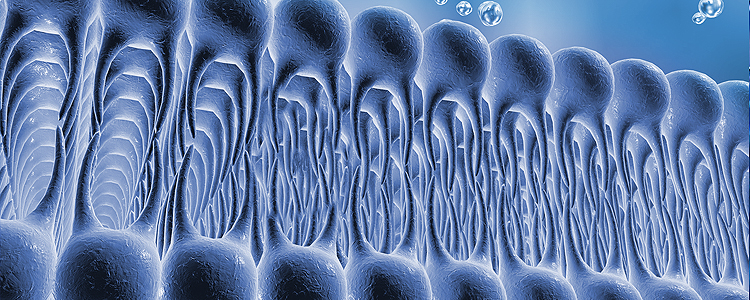
Purified GPCR & ion channel membrane preps for binding & functional analysis
Read More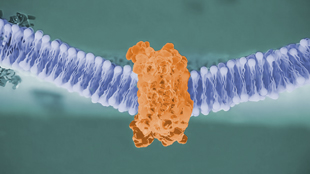
Quantitative cell-based assays to identify pharmacochaperones that stabilize & correct disease-relevant mutant GPCRs, ion channels, or transporters
Read More
Custom cell lines, kits, assays, & protein development capabilities optimized to fit your requirements
Read More
